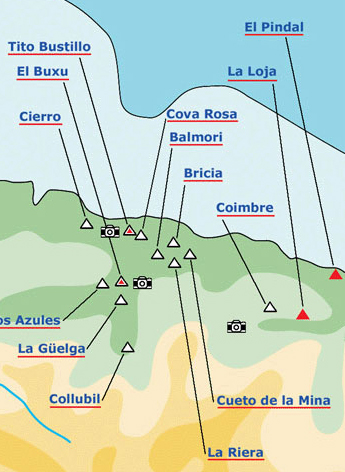Photo Archives: Paleolithic Art in Northern Spain
La Loja
Preview Edition
- 9 photos(about1280x1000,1470x980/JPEG) .
- Commentary by César González Sainz & Roberto Cacho Toca, Univ. of Cantabria.
- Royality Free for private and educational use.
In this downloadable photo archives are contained 9 photos of Paleolithic cave art of La Loja cave with the archeological data and commentary as shown in this preview pages. Only the small sized reference images and a part of commentary are shown in this preview edition, but if you are interested to see more and to use these photos, please go to Kagi store and purchase the data package. Once payment has been made at the Kagi store, you will receive an e-mail containing the URL to download the data package. All photos that are contained in this package are ROYALITY FREE for private and educational use.
 La Loja Cave
La Loja Cave
Cueva de La Loja is situated in the village of El Mazo, (Council of Peñamellera Baja) in the very east of Asturias, very near to the boundary with Cantabria. The cave entrance is just a few meters from the River Deva, on its left bank, in the natural gap between the coastal fringe, and the two inland valleys of the River Cares, coming from the south of Sierra del Cuera, and the River Deva, descending from the mountains of Picos de Europa. The cave is now only ten kilometers from the coast, but it must have been further away when the prehistoric engravings were executed, due to marine regression in the last glaciation.
As in the case of many caves with prehistoric artifacts, Cueva de La Loja was already known to the villagers when, on August 23rd 1908, H. Alcalde del Rio, H. Breuil and L. Mengaud discovered the Paleolithic engravings and paintings. After the discovery, the parietal art was studied in a brief season of fieldwork, and the results were published three years later in Les cavernes de la region cantabrique. This included studies made in another sixteen Cantabrian caves with Paleolithic cave art, and was the first synthesis of Paleolithic Art in the North of Spain. Since then, Cueva de La Loja has been referred to in numerous books on history of art, and in works summarizing certain aspects of Paleolithic art, such as chronology, animal iconography or signs.
In recent decades a few details and comments have been added to the study carried out in 1911. One of these was published in 1978, by J. M. Gómez Tabanera, who revised the art and proposed new interpretations of two of the figures.
-------------------------------------
[References]
Alcalde del Rio, H., Breuil, H., Sierra, L. 1911: Les cavernes de la region cantabrique. Imp. A. Chene. Monaco.
Gómez Tabanera, J. M. 1978: Para una revisión del arte rupestre de la cueva de La Loja. Boletin del Instituto de Estudios Asturianos, 93-94, pp 385-449.
González Echegaray, J., González, C. 1994: Conjuntos rupestres paleoliticos de la Cornisa Cantábrica. Complutum, 5, pp. 21-43.
|
Photographed by Takeo Fukazawa & Co-Project Team of Texnai Inc. and the University of Cantabria
Commentary by César González Sainz & Roberto Cacho Toca, Univ. of Cantabria
Texnai Inc.:
2-1, Udagawa-cho, Shibuya-ku, Tokyo, Japan. Tel:03-3464-6927 Fax:03-3476-2372
e-mail:info@texnai.co.jp
Copyright reserved by Takeo Fukazawa &Texnai, Inc., University of Cantabria, IPA
|
|